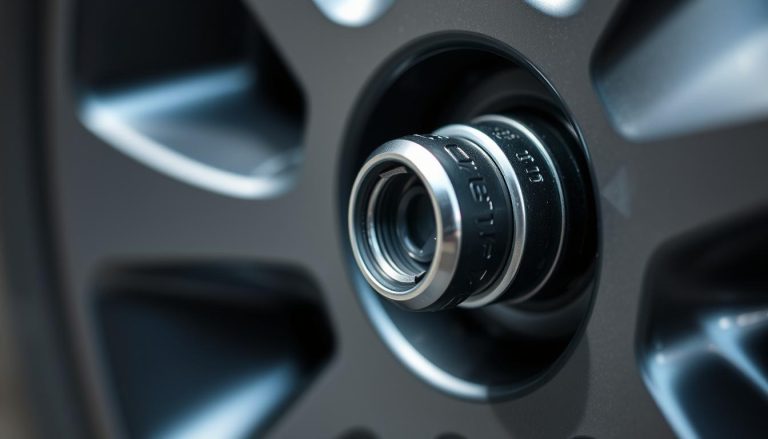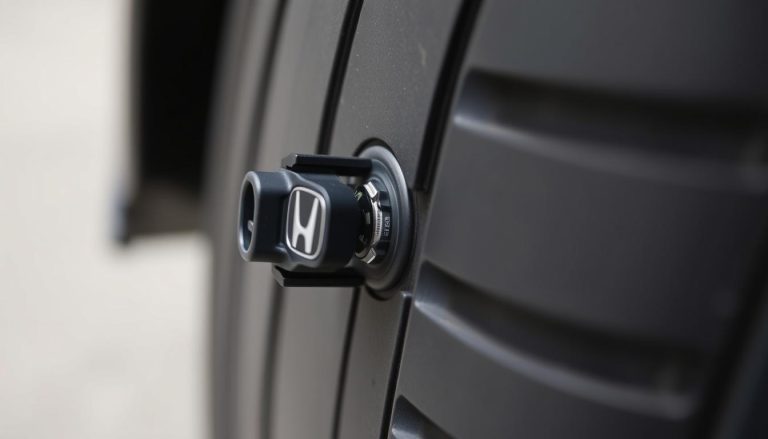Reset the Tire Pressure Light on Your Honda Civic
Driving a Honda Civic means knowing your car’s warning systems. The tire pressure light is key to watch. Learning how to reset it can save time, avoid damage, and keep you safe.
Every Honda Civic owner sees the tire pressure warning light. It can light up for many reasons, like temperature changes or tire pressure issues. Knowing how to reset it is vital for your car’s performance and safety.
Tire pressure monitoring is important for your car’s fuel use, tire life, and driving feel. Wrong tire pressure can cause more fuel use, uneven wear, and unsafe driving.
Modern Honda Civics have advanced Tire Pressure Monitoring Systems (TPMS). These systems check your tire’s air pressure all the time. If they find a big difference from the recommended pressure, they turn on the warning light.
This guide will show you how to reset the tire pressure light on your Honda Civic. You’ll learn the steps for different models, the tools you need, and how to keep your tires at the right pressure.
Knowing how to reset the tire pressure light is useful for all Honda Civic owners. By the end of this article, you’ll know how to handle tire pressure warnings fast and right.
Understanding Your Honda Civic’s Tire Pressure Monitoring System
The Honda Civic’s tire pressure monitor system reset (TPMS) is a key safety feature. It keeps drivers updated on their vehicle’s tire health. Modern cars use advanced tech for the best tire performance and safety.
Tire pressure monitoring systems have gotten smarter in new cars. The main aim of a TPMS is to warn drivers when tire pressure is too low. This helps avoid accidents and saves fuel.
Key Components of the TPMS System
- Tire pressure sensors inside each wheel
- Central receiver module
- Dashboard warning light
- Electronic control unit
How TPMS Sensors Function
The Honda Civic’s TPMS reset system uses electronic sensors in each tire’s valve stem. These sensors check tire pressure all the time and send data to the car’s computer.
Sensors measure tire pressure in two ways:
- Direct measurement: Electronic sensors inside each tire
- Indirect measurement: Uses wheel speed sensor data to find pressure changes
Different Types of TPMS in Honda Civics
Honda Civics use two main TPMS technologies:
- Direct TPMS: Used in most recent models
- Indirect TPMS: Found in older models
Knowing how your Honda Civic’s TPMS works is key for keeping it safe and well-maintained.
Common Reasons Why Your Tire Pressure Light Illuminates
The Honda Civic tire pressure warning light can turn on for many reasons. It signals possible issues with your vehicle’s tires. Knowing these reasons helps drivers reset the light more easily.
Drivers face several common situations that turn on the tire pressure monitoring system (TPMS):
- Seasonal Temperature Changes: Big temperature changes can make tire pressure go up and down
- Slow air leaks from punctures or valve stem damage
- Normal tire wear and aging
- Sensor battery getting old
Tire pressure can drop a lot because of outside factors. A 10-degree Fahrenheit change can make tire pressure go down by about 1 PSI. This might turn on the Honda Civic tire pressure warning light reset process.
| Cause | Potential Impact | Recommended Action |
|---|---|---|
| Temperature Fluctuations | 1-2 PSI Pressure Change | Check and adjust tire pressure |
| Tire Punctures | Continuous Pressure Loss | Inspect and repair/replace tire |
| TPMS Sensor Malfunction | Incorrect Pressure Readings | Professional sensor diagnostic |
Drivers should check tire pressure often. This prevents unexpected warning light turns on and keeps your vehicle running well.
Essential Tools and Requirements for Resetting TPMS
Resetting the tire pressure light on your Honda Civic needs careful planning and the right tools. Before starting, make sure you have the necessary equipment and follow important safety steps.
Required Equipment
To reset your Honda Civic’s tire pressure monitor, you’ll need a few things:
- Digital tire pressure gauge
- Air compressor or tire inflation device
- Owner’s manual for your specific Honda Civic model
- Protective gloves
- Flashlight (optional but recommended)
Safety Precautions
Working with your vehicle’s tire pressure system requires safety. Always ensure your Honda Civic is parked on a level surface with these precautions:
- Engage the parking brake
- Turn off the engine
- Work in a well-ventilated area
- Wear protective eyewear
- Avoid working near open flames or sparks
Preparing Your Vehicle
Before resetting the tire pressure light, prepare your vehicle well. Check tire pressures when tires are cold, like in the morning or after three hours of being stationary.
Look for the recommended tire pressure on a sticker inside the driver’s side door frame. Adjust each tire to the exact pressure, making sure all four tires have the same pressure.
Pro tip: Keep a reliable tire pressure gauge in your vehicle for regular checks. This helps prevent future TPMS warning lights.
How to Reset Tire Pressure Light Honda Civic
Resetting the tire pressure light on a Honda Civic is easy and saves time. The steps to reset the tire pressure sensor vary by model year. But, most methods are similar.
Before you start, make sure you have these items:
- Vehicle owner’s manual
- Tire pressure gauge
- Air compressor or tire inflation device
The steps to reset the tire pressure light are:
- Check that all tires are at the right PSI
- Turn the ignition to “ON” without starting the engine
- Find the TPMS reset button (usually under the steering wheel)
- Press and hold the reset button until the light blinks
- Wait for the system to recalibrate
Pro tip: Always check your Honda Civic model’s manual for exact reset steps. The method can change with model years.
Most Honda Civic models have a smart tire pressure system. It automatically checks pressure changes. When it finds the right pressure, the warning light should go off. If the light stays on, you might need a pro to help.
Step-by-Step TPMS Reset Process for Different Honda Civic Models
Resetting the tire pressure monitor system (TPMS) can vary by Honda Civic model year. Knowing the right steps for your car ensures accurate tire pressure monitoring. It also helps avoid safety issues.
The process to reset the Honda Civic tire pressure monitor system differs by model age. Drivers must follow specific steps to reset it correctly.
Newer Honda Civic Models (2016-2023)
For newer Honda Civic models, the reset process involves several key steps:
- Ensure all tires are properly inflated to recommended PSI
- Locate the TPMS reset button typically under the steering wheel
- Turn the ignition to the “ON” position without starting the engine
- Press and hold the TPMS reset button for 3-5 seconds
- Wait for the tire pressure light to blink and then remain steady
Mid-Range Honda Civic Models (2006-2015)
Slightly older Honda Civic models require a somewhat different reset approach:
- Check tire pressure on all four wheels
- Drive the vehicle at speeds above 30 mph for 10-15 minutes
- Allow the system to automatically recalibrate sensors
- Note: Some models might require manual reset through the vehicle’s computer system
Classic Honda Civic Models (Pre-2006)
Older Honda Civic models often need manual intervention for the tire pressure light reset. These vehicles might require professional diagnostic tools or a visit to a certified Honda service center to reset the TPMS system effectively.
Regardless of your Honda Civic’s age, always consult the owner’s manual for the most accurate reset instructions specific to your vehicle model.
Troubleshooting When Reset Doesn’t Work
Having trouble with a Honda Civic TPMS reset can be really frustrating. Most of the time, resetting the tire pressure warning light is easy. But sometimes, you need to take extra steps to fix the problem.

If the tire pressure warning light won’t go away after you try to reset it, don’t worry. There are important steps you can take to find out what’s wrong:
- Make sure you’re checking the tire pressure right
- Look for any damage on the TPMS sensors
- Check if the tires and wheels are in good shape
- See if the TPMS sensor batteries are working well
There are also specific ways to figure out what’s going on with your TPMS system:
| Issue | Potential Solution |
|---|---|
| Inconsistent pressure readings | Recalibrate all four tire sensors |
| Persistent warning light | Professional diagnostic scan |
| Sensor battery weakness | Replace individual TPMS sensor |
If you can’t fix it yourself, it’s time to get help from a pro. Honda certified technicians have the right tools to find and fix problems that are hard to spot.
If you’ve tried resetting it many times and it doesn’t work, it’s time for a full check-up. This will help avoid any safety issues with your tires.
Maintaining Proper Tire Pressure in Your Honda Civic
Keeping the right tire pressure is key for your Honda Civic’s performance and safety. It affects fuel efficiency, handling, and how long your tires last. Knowing how to reset the tire pressure light is important.
Your Honda Civic’s tire pressure monitor system needs the right pressure to work well. Many things can change tire pressure, so checking it often is important for keeping your car in good shape.
Recommended PSI Levels
Every Honda Civic model has its own recommended tire pressure. Most Civic models need:
- Front tires: 32-35 PSI
- Rear tires: 32-35 PSI
- Spare tire: 60 PSI
You can find the exact PSI for your Civic in three places:
- Driver’s side door jamb
- Fuel filler door
- Owner’s manual
Seasonal Pressure Adjustments
Temperature changes affect tire pressure a lot. For every 10-degree Fahrenheit drop, tire pressure decreases by about 1 PSI. This means you might need to reset your Honda Civic’s tire pressure monitor system more often in winter.
Here are some tips for adjusting tire pressure with the seasons:
- Check tire pressure every month
- Adjust pressure when the temperature changes a lot
- Fill tires when they’re cold for the most accurate reading
Keeping the right tire pressure helps your car run better, stay safe, and avoids unnecessary resets of the tire pressure monitor system.
When to Seek Professional Help

Resetting your Honda Civic’s tire pressure sensor can sometimes need a pro’s touch. Many drivers reset it on their own without issues. But, some cases need special knowledge and tools.
When should you get help for your Honda Civic’s tire pressure sensor reset? Look out for these signs:
- Persistent warning light after many reset tries
- Odd sensor behavior or random warnings
- Need for complex diagnostic steps beyond basic resets
- Signs of sensor hardware trouble
Professional mechanics have the right tools for Honda Civic tire pressure systems. These tools can spot problems not seen in simple resets.
Certified Honda techs do deep diagnostics, like:
- Testing sensor functions
- Checking electronic systems
- Advising on sensor replacements
- Calibrating tire pressure systems
Getting professional help can avoid long-term damage and keep your Honda Civic’s system working well. While DIY resets often work, knowing when to call a pro can save time, money, and safety.
Preventing Future TPMS Warning Light Issues
Keeping your Honda Civic’s tire pressure monitoring system (TPMS) in good shape is key. It starts with knowing how to take care of your tires. By following some simple maintenance tips, you can avoid unexpected tire pressure warnings and drive safely.
Regular Maintenance Strategies
Regular tire care is essential to avoid Honda Civic tire pressure light resets. A good maintenance plan can help reduce TPMS warnings.
- Conduct monthly tire pressure checks
- Rotate tires every 5,000-7,500 miles
- Inspect tire tread depth quarterly
- Balance wheels annually
Best Practices for Tire Care
Looking after your Honda Civic’s tires is more than just checking pressure. There are smart ways to make your tires last longer and avoid needing a TPMS reset.
| Practice | Benefit |
|---|---|
| Avoid curb impacts | Prevents wheel alignment issues |
| Store tires properly | Maintains tire integrity |
| Check tire pressure before long trips | Ensures optimal performance |
Proper wheel alignment is vital in Honda Civic TPMS reset prevention. Misaligned wheels can lead to uneven tire wear. This causes pressure problems that turn on the tire pressure light.
Regular tire maintenance can save you from unexpected TPMS warning light issues. By sticking to these tips, you’ll keep your Honda Civic’s tires in top shape. This means you’ll need to reset the tire pressure light less often.
Understanding TPMS Sensor Battery Life and Replacement

The tire pressure monitor system (TPMS) in your Honda Civic uses battery-powered sensors. These sensors are key to keeping your vehicle safe and running well.
TPMS sensor batteries usually last 5 to 10 years. Several things can affect how long they last:
- Driving frequency
- Environmental conditions
- Sensor quality
- Vehicle maintenance
It’s important to know when your TPMS sensors might be failing. Look out for these signs:
- Intermittent tire pressure warnings
- Inconsistent pressure readings
- Sudden TPMS light activation
If your Honda Civic’s tire pressure monitor system needs a reset because of sensor battery issues, you have choices. You can either have a professional replace the sensors or do it yourself. Professionals can quickly find and replace the sensors, making sure your pressure is always right.
Replacing the sensors can cost between $50 and $250, depending on your Honda Civic model and sensor type. Some newer models have better sensors with longer battery life and more features.
Impact of Tire Rotation and Replacement on TPMS
Tire care is key for your Honda Civic’s Tire Pressure Monitoring System (TPMS). Regular rotations and replacements affect the TPMS. They might need special reset steps.
When you rotate tires, resetting the Honda Civic’s tire pressure warning light is vital. Moving tires around can wake up the TPMS sensors. You’ll need to reset them to keep the pressure monitoring right.
- Tire rotation moves each tire to a new wheel spot
- TPMS sensors might need to be recalibrated after rotation
- Some Civic models need special reset steps
Replacing tires brings more to think about for resetting the light on a Honda Civic. New tires must be compatible with existing TPMS sensors. Owners should think about replacing sensors too.
Important things to consider with tire replacement and TPMS include:
- Check the sensor battery life when changing tires
- Make sure new tires match the original specs
- Check if the TPMS sensors are compatible
Experts say to get a full system check after big tire work. This ensures accurate pressure monitoring and the best car performance.
State Regulations and TPMS Requirements

Tire Pressure Monitoring Systems (TPMS) are more than just a safety feature in your Honda Civic. They are now a critical legal requirement across the United States. The federal government mandated TPMS in all passenger vehicles made after 2007. This set a nationwide standard for vehicle safety.
Different states have varying approaches to TPMS enforcement. Knowing these regulations helps Honda Civic owners stay compliant and avoid penalties.
- Vehicle safety inspections now include TPMS functionality checks
- Disabled or non-functional tire pressure sensors can result in registration issues
- Potential fines for ignoring Honda Civic low tire pressure light reset warnings
State-specific regulations make the landscape for Honda Civic tire pressure sensor reset procedures complex. Some states enforce rules more strictly than others.
| State | TPMS Inspection Requirement | Potential Penalty |
|---|---|---|
| California | Mandatory during smog check | Registration hold |
| Texas | Vehicle safety inspection | Fine up to $200 |
| New York | Annual vehicle inspection | Repair requirement |
Keeping your Honda Civic’s TPMS in good shape ensures legal compliance and boosts vehicle safety. Regular checks and timely Honda Civic low tire pressure light reset can prevent issues during state inspections.
Conclusion
Learning to reset the tire pressure light on your Honda Civic is key to car care. It ensures your tires work well, keeping you safe and saving fuel. Knowing how to do this keeps your car running smoothly.
But, it’s more than just resetting the light. It means you’re aware of a problem that needs fixing fast. Checking your tires, knowing how sensors work, and fixing issues quickly can save you money and keep you safe.
When resetting the TPMS, pay close attention to your Honda Civic’s model year. Each model might need a different way to reset. Keeping up with tire care, knowing your car’s needs, and being proactive will help you manage your car’s tire pressure system well.
While resetting the light is important, it’s not a fix for all problems. Regular checks, seasonal tire inspections, and knowing your TPMS system are vital. They keep your Honda Civic running well and safely for a long time.







